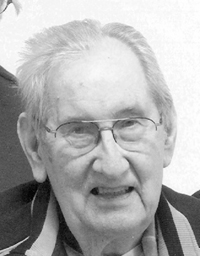In Memoriam: Harold V. Larson
1924-2008
by Ronald L. Kathren, CHP

The health physics community lost one of its most colorful, productive, highly respected, and beloved elder statesmen with the passing of Harold V. Larson on 5 September 2008. Harold was born on 15 December 1924 in Portland, Oregon. His father died when he was 13, forcing him to go to work to support his family during the latter years of the Great Depression. After graduation from high school, he enlisted in the U.S. Army Air Force, serving in combat in the South Pacific. His decorations included the Philippine Liberation Medal and the World War II Victory Medal.
Aware of his less-than-stellar high school grades, he arranged to have all of his high school textbooks except those from his English classes sent to him in the South Pacific to prepare for his post-war enrollment at Oregon State University, which required him to take a special entrance exam. He scored exceptionally well in all areas except English and was called in for a special interview and suspected of cheating. The academics could not understand how anyone could get 100 percent on the mathematics test and fail English. Harold went on to earn a BS and MS in physics, taking (and passing!) dumbbell English in the process.
His thesis research was an investigation of the Bragg-Gray principle with fluorescent x rays in which he provided important information and a new value for the work function constant W in the Bragg-Gray equation (Rad. Res. 5:558-568; 1958). This work led to development of a wide-beam K fluorescence radiator (Nucleonics 13[11]:100; 1958) widely used today for radiological calibrations by primary standards laboratories to produce photon beams with known discrete energies in the region below 100 keV, and which quite properly should be known as the Larson radiator. He also measured values of W for protons in Ar, N2, CO2, dry air, and “tissue-equivalent" gas (Phys. Rev. 112:1927-8; 1958).
Harold began his professional career in health physics with General Electric in 1952 at the Hanford site, where he spent his entire career, ultimately retiring from Battelle Northwest Laboratories in Richland, Washington. He made important technical contributions in many areas—film dosimetry, instrumentation, in vivo counting, and emergency response—and played a key role in post-accident dosimetry of the Recuplex criticality. He ultimately was appointed head of the Occupational and Environmental Safety Department, which included the Hanford plant-wide environmental monitoring and evaluation program.
Early in his career he was active in the Atomic Energy Commission (AEC) Fellowship program, commuting to Seattle one day a week to teach courses in radiological sciences at the University of Washington.
Technically and managerially competent, understanding of people and their problems, gregarious, jovial, and dedicated to development and betterment of his staff and his program, Harold excelled as a manager. He was an excellent mentor and role model and could come up with practical and often highly creative solutions to vexing problems not covered by the textbooks. For example, Harold's memory for names was very bad. To assist him in remembering the 150+ members of his department, he maintained an organization chart on the wall outside his office with the name, title, and photograph of each member of the department in proper organizational position. Working for him was fun; he was always cheerful (so much so that he was known as “Happy Harold" among his colleagues at the local AEC office) and often a bit unpredictable; there was never a dull moment.
Over the years he served on numerous technical and Health Physics Society (HPS) committees on both the national and chapter level, as president of the Columbia Chapter of the HPS (1970), and on the HPS Board of Directors (1977-1980). He was honored by election as a Fellow of the HPS, received Columbia Chapter Life Membership, and was a certified health physicist and an Emeritus member of the American Academy of Health Physics.
His contributions went far beyond health physics. He devoted a major portion of his life to the Boy Scouts, which honored him with the prestigious Silver Beaver Award. Harold was also an active member in his church, serving as an elder, a Sunday School and Bethel Bible Series teacher, director of Camp Ghormley, and chair of the Fuller Theological Seminary Steering Committee.
He is survived by a loving wife of 60 years, Zoe Thompson Larson, five children, eight grandchildren, and three great-grandchildren.
Rest well, old friend; you leave behind some mighty large footprints and some equally large shoes to fill and so many whose lives you helped to enrich and whom you cheered with your infectious good spirit and happiness.




